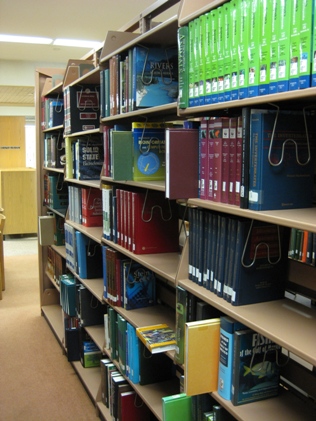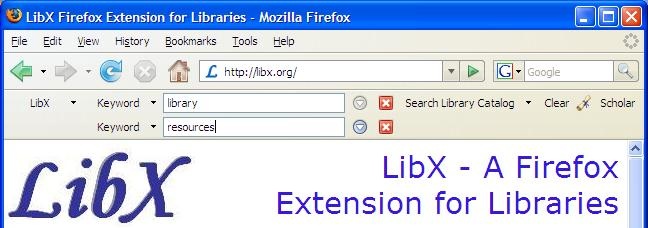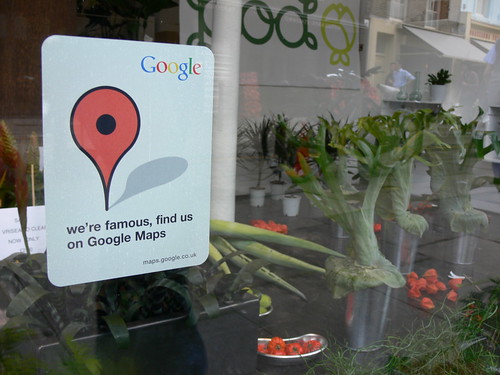The production upgrade to Encore 4.0 is complete. There are some new features in place and other customizations that are upcoming. Please take it for a test drive, kick the tires and let us know what you think.
Category: Resources & Technology
GLBT History Month
October is GLBT History Month, and the Scranton Inclusion student group will be celebrating the achievements of GLBT icons throughout history. If your interest is piqued by the flyers you’ll be seeing around campus, why not stop by the Library to learn a little more about GLBT history?
We have some relevant books, like…
- Vicki Eaklor’s Queer America: A GLBT History of the 20th Century
- David Carter’s Stonewall: The Riots That Sparked the Gay Revolution
- Sonya Jones’s Gay and Lesbian Literature Since World War II: History and Memory
- Reed Woodhouse’s Unlimited Embrace: A Canon of Gay Fiction
- Lillian Faderman’s Odd Girls and Twilight Lovers: A History of Lesbian Life in Twentieth-Century America
You can also read the works and biographies of GLBT icons including…
And don’t forget that you can take a look at our GLBTQ Inclusion Research Guide for additional resources on GLBTQ issues.
Important Maintenance
On October 2, 2010, between 6AM and 12PM, there will be no off campus access to the My. Scranton portal, the library databases and the library “My Account” service. The outage is temporary and necessary to apply server updates.
LibX Catalog Search Toolbar
The library now has a catalog search toolbar that you can install in your internet browser. The toolbar is called LibX it is an open source product that’s super easy to use! You can visit the University of Scranton’s LibX Edition instruction page to install it. On the top of the page, there’s a link to install in Firefox or Internet Explorer. Once it has been installed, you will have a new toolbar in your browser that looks like this:
The toolbar will let you search the catalog by Keyword, Title, Author, Subject, ISBN, and even Call Number! But LibX doesn’t just let you search from your toolbar. It will also insert our favicon
(this symbol ![]() ) into certain websites, like Amazon, Google and The New York Times. When you see that symbol, you can click it and it will execute a search into our catalog. For example, if you’re looking at a book in Amazon, you can click the icon next to the title and it will search our catalog for that particular book! Also, if you do a search in Google, you will see the symbol in your results list, if you were to click the icon it would perform the same search but in our catalog.
) into certain websites, like Amazon, Google and The New York Times. When you see that symbol, you can click it and it will execute a search into our catalog. For example, if you’re looking at a book in Amazon, you can click the icon next to the title and it will search our catalog for that particular book! Also, if you do a search in Google, you will see the symbol in your results list, if you were to click the icon it would perform the same search but in our catalog.
That’s not all it does, either! It will also allow you to highlight any text on a website and by right-clicking with your mouse, you can choose to search our catalog for that information. And finally, it will also hyperlink any ISBN in any website, so you can simply click an ISBN which will search our catalog. I hope you find this useful in streamlining your research and searching techniques!
Advanced notice of database maintenance
On Saturday October 2, 2010 starting at 5AM EST, the Wiley Online Library will not be available due scheduled maintenance. The tech support announcement estimates the maintenance to last for a period of two hours.
Get Where You’re Going with Google Maps
Image courtesy of Lars Ploughmann, under a Creative Commons license
Our Technology On Your Own Terms series continues on Tuesday, October 12 from 12pm – 1pm in WML306 with a workshop titled Get Where You’re Going with Google Maps, taught by digital services librarian Kristen Yarmey:
Many people know that you can use Google Maps to get driving directions from one place to another. But did you know that you can also use Maps to scope out a vacation destination, find the closest Italian restaurant, or make a custom map for a friend or a project? In this workshop, you’ll explore specialized features and tools available in Google Maps to help you get where you want to go.
Remember, all faculty and staff members are welcome, but seats are limited, so if you plan to attend, please register at www.scranton.edu/ctleregistration (select Special Event). Hope to see you there!
Update on Peer-to-Peer File Sharing
This morning, the University’s CIO Jerry DeSanto sent out a reminder to all University community members about peer-to-peer file sharing. We’ve posted about this before (see “What Students Should Know about Peer-to-Peer File Sharing”), but it’s such an important issue that it bears repeating. There were also some new regulations that took effect over the summer that students and faculty should be aware of.
Don’t forget: if you have questions about copyright, you can always ask a librarian!
Here’s the text of VP DeSanto’s email:
Members of the University Community:
Greetings from the Planning and Information Resources Division — We have been hard at work during the summer months making improvements to the classrooms and computer labs, data center, enterprise applications and related services used to conduct the work of our campus community. Our technology infrastructure allows us to share resources and collaborate with each other and colleagues around the world in numerous, productive ways. I want to remind you that, while using the University’s technology resources, we have all agreed to abide by the Code of Responsible Computing and Student Computing Policy.
On July 1, 2010, final regulations from the federal government specific to the use of peer-to-peer (P2P) file sharing applications within colleges and universities took effect. Peer-to-peer file sharing is widely used to exchange files, most commonly music and video; however, the unauthorized distribution of copyrighted material may subject the individuals involved to civil and criminal penalties. In general, anyone found liable for civil copyright infringement may be ordered to pay either actual damages or “statutory” damages affixed at not less than $750 and not more than $30,000 per work infringed. For “willful” infringement, a court may award up to $150,000 per work infringed. Willful copyright infringement can also result in criminal penalties, including imprisonment of up to five years and fines of up to $250,000 per offense. Colleges and universities can be required to identify offenders within their network(s); The University of Scranton will comply with any court orders it may receive.
The University limits the amount of bandwidth allotted to peer-to-peer applications in order to ensure the availability and integrity of our network and services. In addition, we prohibit the use of those aggressive peer-to-peer applications that utilize excessive network resources or are known to carry mostly illegal content. As stated in the University’s Copyright Compliance and Peer-to-Peer File Sharing Policy , individuals who are in violation of policy will be subject to disciplinary action, which may range from written warnings, fines, counseling, and/or suspension of network access. If you have any questions about this please contact the Technology Support Center at 941-HELP (x4357).
Best wishes for a very rewarding academic year.
Sincerely,
Jerome P. DeSanto
Vice President for Planning and CIO
A New Home for Science Reference

Our science reference books have moved! No longer do they sit alone on the third floor, isolated from the rest of the reference section. You’ll now find them integrated into our second floor reference collection, enjoying the company of the other disciplines.
Does the Weinberg Library have my textbook?
Does the Weinberg Library have my textbook?
No, The Weinberg Library does not purchase textbooks. Textbooks are updated much more frequently than the traditional library book, thus making them difficult to keep up-to-date. On the slim chance that we may have acquired the textbook for your class, it would be listed in the Online Catalog. To check, simply access the “Our Catalog” link from the Library’s homepage and type in the exact title of the textbook (editor or author is helpful, since most textbooks have generic names such as Fundamentals of Psychology, Microeconomics, etc.) Supplemental reading, such as a short story or essay may be found in collections of typical library books. Use the procedure listed above to see if the book is here.
Length of loan can also be problematic, since books circulate for one month, and you need your textbook for an entire semester.
You may also try E-Z Borrow (PALCI), a direct borrowing service found as a link from the Library’s Homepage. Your Royal Number is your login for this service. Check the holdings information on this search, since many libraries may have the book, but it could be already checked out.
Technology on Your Own Terms Fall 2010
Each semester, the Weinberg Memorial Library and the Center for Teaching & Learning Excellence (CTLE) offer a faculty and staff advancement series called Technology on Your Own Terms. The series introduces University faculty and staff to emerging technologies in a hands-on environment, in order to encourage innovation in the workplace and in the classroom. We’re continuing the series in Fall 2010 with a theme of “Get to Know Google,” featuring workshops on four different Google services. All workshops take place in Rm. 306 of the Library.
Just Google It!
Tuesday, September 14 from 12pm – 1pmOne billion results in 0.27 seconds! When you need information, chances are you use Google™ to find it. In this workshop, you will learn how Google’s Web search engine works. You will also learn some tips to help you improve your search experience as well as some of Google’s special features, such as Google Books and Google Scholar. (Taught by Bonnie Oldham, Weinberg Memorial Library)
Google Docs: An Excellent Way to Create, Collaborate on, and Securely Store Documents
Friday, October 1 from 12pm – 1pmThis workshop will introduce you to Google Docs, a service that allows you to create documents that parallel Microsoft Office: Word, Excel, and Powerpoint. It also allows for the creation of online surveys and the storage of any type of document in a very secure environment. Google Docs offers excellent collaborative opportunities for working on any supported document type with both peers and students, meaning that the tool can be used for course paper submissions, faculty feedback, collaborative student projects, club, or research purposes. (Taught by Dr. Tim Cannon, Psychology/Neuroscience)
Get Where You’re Going with Google Maps
Tuesday, October 12 from 12pm – 1pmMany people know that you can use Google Maps to get driving directions from one place to another. But did you know that you can also use Maps to scope out a vacation destination, find the closest Italian restaurant, or make a custom map for a friend or a project? In this workshop, you’ll explore specialized features and tools available in Google Maps to help you get where you want to go. (Taught by Kristen Yarmey, Weinberg Memorial Library)
Does Google Give You A Voice?
Thursday, November 4 from 12pm – 1pmIn this workshop, we will explore Google Voice, a recently-made-public service of the search giant. Google Voice offers one central phone number, which can be setup to call your other phones based on caller, time of day, etc. Other features of the service include visual voicemail, personalized greetings, voicemail transcription, international calling, and a lot more. It is easy to set up… Learn how! (Taught by Eugeniu Grigorescu, CTLE)
All faculty and staff members are welcome, but seats are limited, so please register for sessions you plan to attend at www.scranton.edu/ctleregistration (select Special Event).




